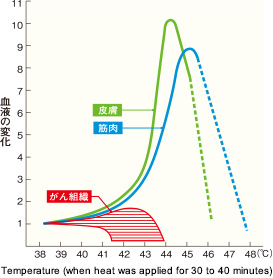Principle of hyperthermia
Hyperthermia (for cancer treatment) heats local cancer tissues for 30 to 60 minutes to 42 to 43°C or higher. In addition to its original therapeutic effects, hyperthermia increases the effects of radio- and chemotherapies, and can be combined with immunotherapy and other treatment.
■The thermo-sensitivity of cancer tissues is higher than that of normal tissues.
In general, pH levels in cancer tissues are lower compared to those in normal tissues, and the thermo-sensitivity of tissues under low-pH conditions is high.
■It is easy to increase the temperature of cancer tissues by heating them.
When cancer tissues are heated, blood flow does not increase or sometimes decreases. Therefore, it is easy to increase the temperature of cancer tissues by heating them because they will not be cooled by blood flow.
■Hyperthermia increases the effects of radiation.
Although radiotherapy is effective in the vicinity of the capillaries in which oxygen partial pressure is high, its effects become lower in areas located far from blood vessels in which the oxygen level is low. Since hyperthermia increases temperatures in areas located far from blood vessels, the effects of radiation and hyperthermia are expected to complement each other.
■Hyperthermia increases the effects of many types of chemotherapeutic agents.
Research results have suggested that hyperthermia facilitates the absorption of chemotherapeutic drugs into the cells of cancer tissues to increase their antitumor effects.

Changes in blood flow in normal skin and muscles and
cancer tissues when they were heated to varying temperatures
※Chang W. Song, Ph. D.



